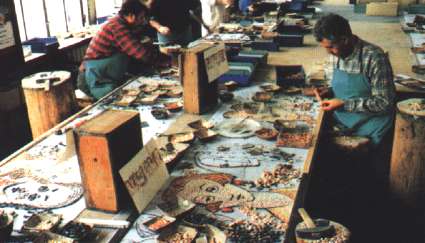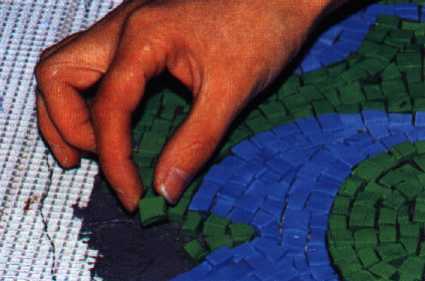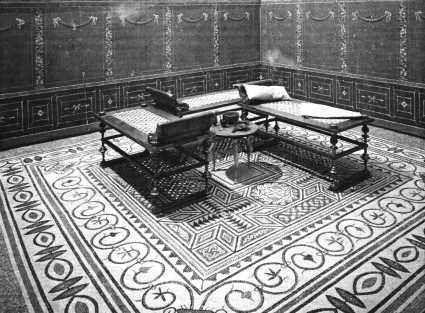
 |

FRANZ MAYER OF MUNICH |
| David
Marks, a gifted mosaicist who specialises in opus regulatum, lives
in the fair city of Munich and kindly agreed to visit the long-established
world-famous Franz Mayer'sche Hofkunstanstalt on our behalf. His host
was Michael Mayer, who was more than happy to tell him the facts about
the family firm.
The company, founded in 1847 to make stained glass and mosaic, flourished from the start and by the turn of the century employed over 500 craftsmen. It has slimmed down somewhat since then, but is still a very impressive enterprise, housed near the city centre in a handsome twenties "Studio", which looks more like a stately mansion, with a spacious modern "Workshop Building" alongside. All that space means they have offices, workshops, studios, exhibition areas and apartments for visiting artists, plus considerable storage capacity - room for some 500 tons of all sorts of stone, for example, and for ample supplies of 3500 different colours of smalti, in pieces or pizzas, usually from Dona, or Orsoni. This is a BIG outfit... (And they have a branch in New York.) Working on Ruben Toledo's Sixty-two Ladies, Barney's, NY, 1994 Stained glass is still half of what they do, and mosaic the other half, and as mosaicists their basic philosophy is that they can do anything, and do it well, and with 150 years of experience they're probably right. They engage designers on a freelance basis, and are as keen to encourage new, young talent as to rely on established artists. Once the design is agreed by the client, they can call on the services of some 25 to 30 mosaicists to turn it into mosaic. One person can prepare up to 2 square metres a day. Two metres is a lot; most mosaicists would be content with one metre a day, and of course it all depends on the complexity of the design, the size of the tesserae, the amount of cutting involved, etc. A really tricky design might take more like 1 square metre per four weeks... They generally work direct (which they call "the positive method"), often onto mesh, or use the reverse technique ("the negative method"), with smalti and stone being the preferred media, though vitreous and ceramic et al are not excluded. Mayer developed their own fibre-glass mesh in the fifties and sixties, and find it very satisfactory. Their adhesives have likewise been developed to the firm's own specifications, in collaboration with the adhesives industry, over the last fifty years. They are based on mineral glues, with additives, and have presented no problems, within doors or without. Kurt von Unruh Spring, 1982, 300x300 cm, stone, smalti, gold, detail They use up to ten fixers to install the finished work, direct or reverse. A team of ten fixers, working in pairs, can lay 25 square metres or more a day. Incidentally, this is much the same rate that our own Brian Bull of Democo quoted when we talked to him back in 1993 (see MM5). Grouting and finishing off are done by assistants. Antje Tesche-Mentzen, Creation, 1991, smalti, gold, stone, detail Size is no problem: making, say, 10,000 square metres of mosaic, which is quite a large area (roughly two-and-a-half acres), would take perhaps a couple of years. With Franz Mayer's many connections and contacts they simply round up sufficient freelance mosaicists to get a given task completed by the stipulated date. They can work in any style - Byzantine, Roman, Victorian, whatever the client requires - and the photographs shown here give an idea of the wide range of Franz Mayer contemporary mosaics, though the firm's excellent brochure and portfolio naturally give a much better idea. For instance, there's a photo nearly 3 foot long of a spectacular wall mosaic by Prof. Karl Knappe. This was a commission to mark the opening of the Munich Odeonsplatz tube station on the occasion of the 1972 Olympic Games. The wall is 10 foot high and 55 foot long, and was made from various types of stone (smooth-cut and rough-cut), semi-precious gems, and tile-sized gold and silver smalti. Done direct, but of course. Prof. Knappe and Mayer have also created a mural mosaic in the World Peace Church at Hiroshima. Being positive with smalti and mesh For the company has customers from all over the world. Michael Mayer looks after those from the Middle East and Far East, Australia and Britain. Notable international commissions include Grand Central Station in New York, the Norte Shopping Centre in Rio de Janeiro, the KKIA Mosque in Riyadh, and St. Peter's, Rome. The brochure also illustrates some of the restoration projects they undertake. Restoration of old mosaics forms around 10 to 20% of the tasks in hand at any one time, and can't be hurried. They worked on the Roman floors at Aschaffenburg for twenty years, and are currently repairing a recently discovered Roman pavement for the Prae-historische Sammlung in Munich. On the other hand they are also frequently summoned to repair 19th and even 20th century work, such as a mosaic by Frank Lloyd Wright in Charnley House, Chicago. Below is a photo of the Roman mosaic floor, beautifully restored by Franz Mayer of Munich, and now on display in the Prähistorisches Staatssammlung (lit. Prehistoric Collection), Munich. It was made in the third century AD in Kraiburg am Inn by mosaicists from the Salzburg area. The museum has constructed a Roman dining room not merely to show the forty-square metre mosaic to best advantage, but also to show it in context - a fairly rare occurrence in museums, and indeed in the world outside. (The photo is by Manfred Eberlein for the Museum.) Now, turning to the stained glass side of the business…
|
All
content is copyright of © Mosaic Matters and its contributors.
All rights reserved
Mosaic
Matters is:
Editor: Paul Bentley
Web Manager/Designer: Andy Mitchell





